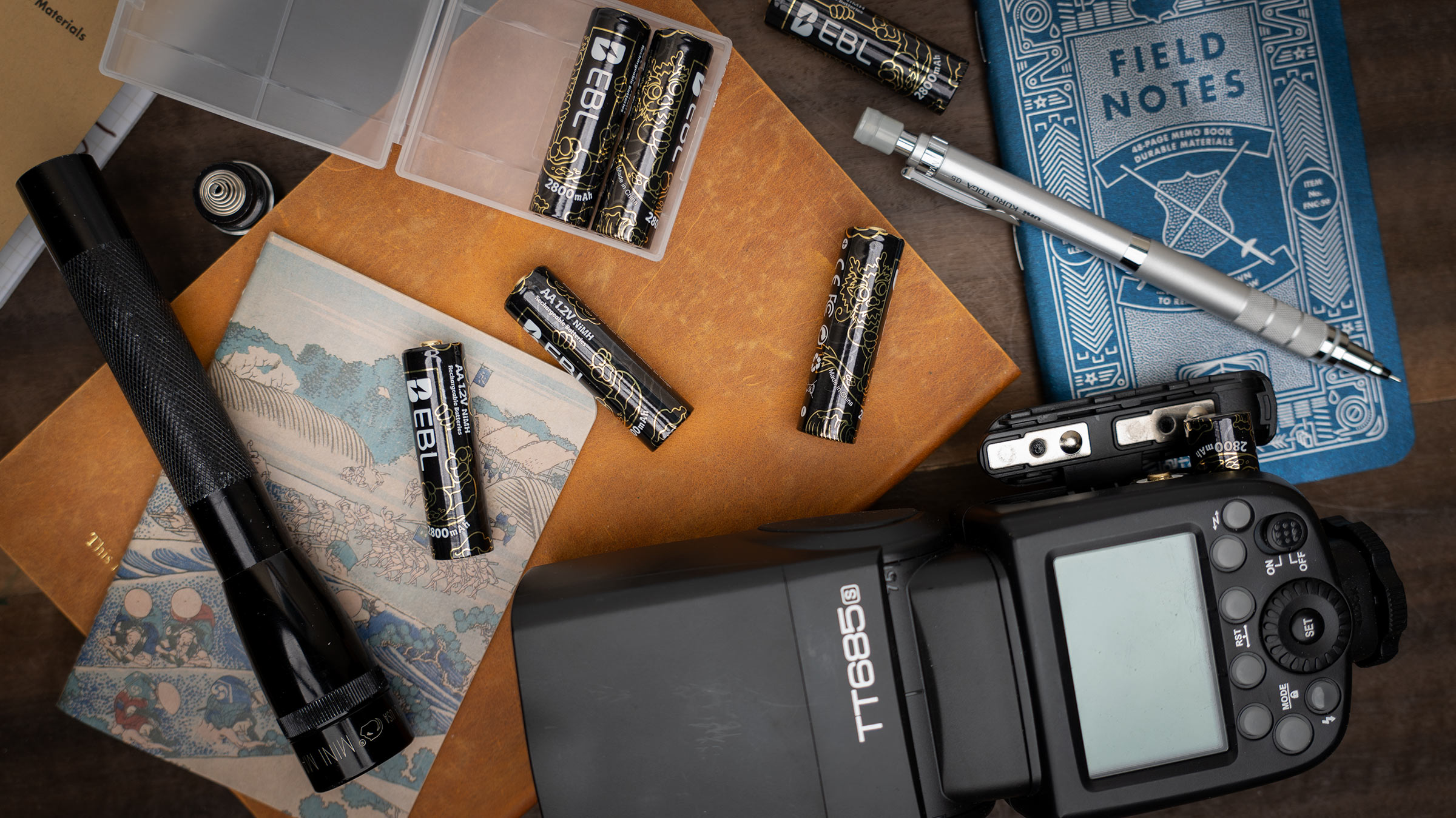A few months ago, EBL contacted me and offered me a set of their standard AA NiMh rechargeable batteries and an 8-slot charger to test and review, and they subsequently sent another set of their new AA and AAA “Year of the Dragon” (hereafter “Dragon”) batteries. Although I’ve used EBL batteries in the past, I had never given them a thorough test, so I’ve been putting them through their paces since then. Are they any good? This is what I discovered.
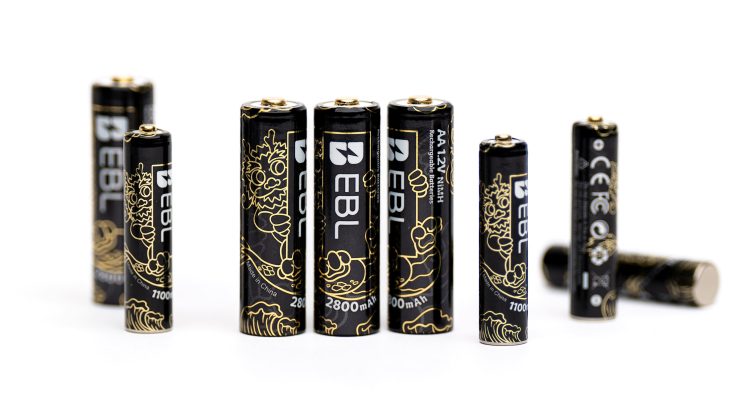
Testing EBL Battery Capacity : Really 2800mAh?
Among all of the wide variety of different AA NiMh batteries that we’ve tested over the years, 2800mAh is the highest capacity that has been claimed by any brand (Bonai also claimed 2800mAh, but their performance did not match it). The EBL standard white-jacket batteries and the AA Dragon batteries both claim to hold 2800 mAh of power on a full charge.
To begin, I’ve run all eight EBL batteries through my Opus capacity tester (the same one that I’ve used on all of my other battery tests), and the EBLs did not fare well.
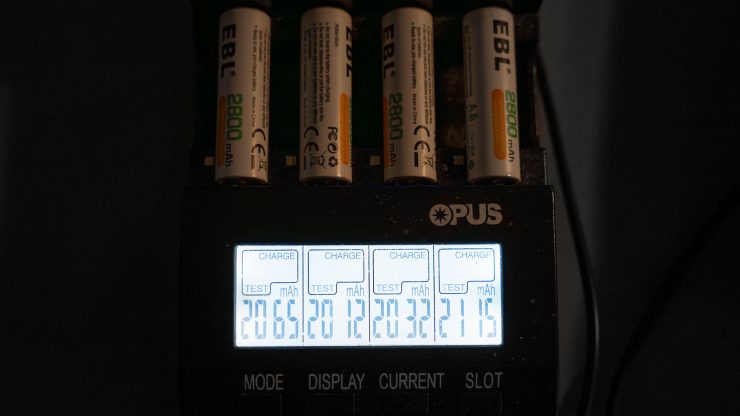
You can see the typical capacity test results in the photo above, where the average capacity of the batteries tested was 2056mAh, nearly 750mAh lower than the claimed 2800.
I contacted EBL at this point to report that the batteries were not performing as claimed, and asked whether this was the anticipated result. The EBL representative responded that the batteries appeared to be faulty, and said that they’d send another set.
And so, a week later, I received the Dragon batteries in the mail. Expecting the same performance, I tested the Dragon batteries and was pleased to discover that the Dragon batteries provided significantly more capacity:
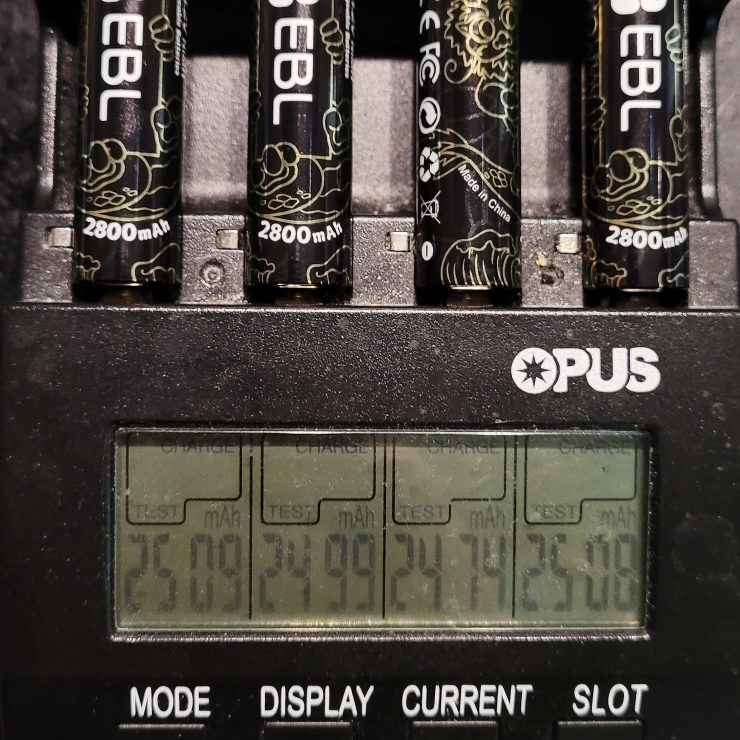
Repeated tests over the following weeks confirmed that the capacity of the Dragon batteries was right around 2500mAh.
This means that among the batteries that I’ve tested over the past decade, the EBL Dragon batteries match the Ikea Ladda 2450mAh batteries as the second highest capacity tested (the the highest capacity tested so far are the PowerexPro 2700mAh), and that is excellent performance.
On the other hand, it is still 300mAh less than the stated capacity, and I have no patience for companies that make extravagant claims about their batteries when they really don’t live up. This takes advantage of the fact that most people don’t have the time or equipment necessary to test their batteries and will never notice the difference, and it is fundamentally dishonest, calling into question every other claim about the batteries: are they really low self-discharge? How many charge cycles will they really last? I don’t know, but I don’t trust EBL to give me accurate information anymore, either.
Similarly, the Year of the Dragon AAA batteries claim a capacity of 1100mAh, but in my tests, they had a capacity of between 950 and 960mAh very consistently.
AA Testing Interior Resistance
Some batteries are better than others at discharging their power quickly, which is very important when it comes to powering flash equipment. Alkaline batteries, for example, hold a lot of power compared to NiCad batteries, but NiCads can release their power dramatically faster, allowing them to improve the recycle time on a strobe significantly as well.
NiMh batteries also generally also have a good output rate. For the following tests, I put four batteries in my Godox TT685 flash unit and set it to manual power, then fired the flash at full power 10 times in a row, as fast as the batteries would let me. For comparison, I tested the EBLs against some 2400mAh Amazon Basics batteries.
| Battery | Average Recycle | Fastest Recycle | Slowest Recycle |
| EBL Original 2800 | 2.46 | 2.3 | 2.68 |
| EBL Dragon | 2.3612.13 / 2.31 / 2.3 / 2.35 / 2.35 / 2.4 / 2.41 / 2.45 / 2.46/ 2.41 / 2.45 | 2.13 | 2.46 |
| Amazon Basics 2400 | 2.77 | 2.61 | 2.83 |
As you can see, the EBLs performed measurably better than the Amazon batteries, although only the heaviest users of flash photography would probably notice the 0.3-0.4 second difference in recycle time.
Self Discharge Test
These batteries are currently in testing for self discharge, which is a slow process. I’ll update this review at intervals as they complete the stages.
AA Price vs Performance
When compared to other batteries with similar performance, the EBL Year of the Dragon batteries are priced very reasonably. For example:
| Battery: | Tested Capacity | Price for 8 Batteries | Price per 100 mAh |
| PowerEx 2700 | 2600 | $22.95 | $0.11 |
| Ikea Ladda 2450 | 2450 | $19.98 | $0.10 |
| Amazon Basics 2400 | 2400 | $13.72 | $0.07 |
| EBL 2800 Dragon | 2500 | $13.99 – $16.99 | $0.07 |
Here you can see that the EBLs match the Amazon basics for the best price per 100mAh, while also offering a higher average capacity, when purchased from Ebay rather than EBL directly, where they cost three dollars more per pack of 8.
The EBL 8 Slot Battery Charger
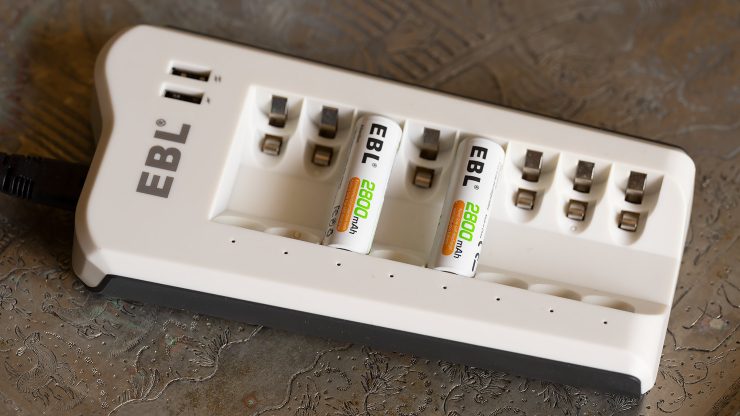
Those of us who shoot events with speedlights end up going through AA batteries very quickly, so it’s important to have large capacity chargers. The EBL that shipped with my original set of batteries is a pretty decent device… especially for the price. Each battery charging channel is handled individually, so it’s not necessary to charge batteries in pairs or charge batteries that are all in the same state of charge. That’s excellent, and the addition of two USB ports for charging additional devices (phones, tablets, cameras, etc) is also pretty handy.
Preliminary Conclusions
The EBL Year of the Dragon batteries that I’ve tested are good batteries in terms of capacity and performance, and I’d happily recommend them if the company had reported their capacity correctly, but they were off by 300mAh, and the standard EBLs are even worse, and the Dragon AAAs were off by 15% as well. I’ve said it before but I’ll say it again: as long as people accept the consistent mis-reporting of performance of budget batteries, these companies will keep doing it, so I can’t recommend actually buying these batteries, regardless of the fact that they seem to be of good quality (in the case of the Dragon batteries, they’re as good as any battery that I’ve tested if we consider price and performance). Instead, I’d buy Ikea Ladda batteries (they’re often less expensive in stores… closer to $7 for 4), or Powerex Pro 2700s if you want higher capacity and don’t mind spending a bit more. If you do decide to get the EBL Dragon batteries, they can be found on EBL’s website.
